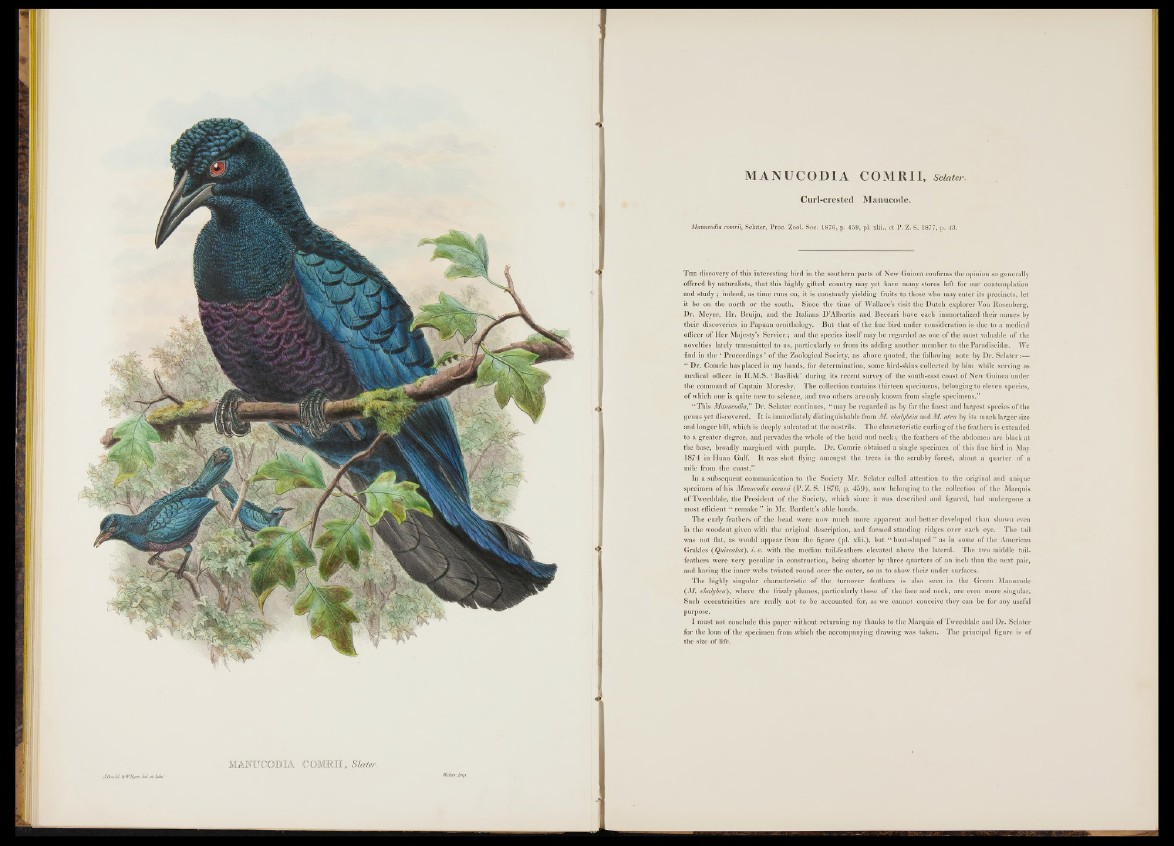
MANUCODIA COMRII, Sclater.
Curl-crested Manucode.
Manucodia comrii, Sclater, Proc. Zool. Soc. 1876, p. 459, pi. xlii., et P. Z. S. 1877, p. 43.
T h e discovery of this interesting bird in the southern parts o f New Guinea confirms the opinion so generally
offered by naturalists, that this highly gifted country may yet have many stores left for our contemplation
and study ; indeed, as time runs on, it is constantly yielding fruits to those who may enter its precincts, let
it be on the north or the south. Since the time o f Wallace’s visit the Dutch explorer Von Rosenberg,
Dr. Meyer, Hr. Bruijn, and the Italians D’Albertis and Beccari have each immortalized their names by
their discoveries in Papuan ornithology. But that o f the fine bird under consideration is due to a medical
officer o f Her Majesty’s Service; and the species itself may be regarded as one o f the most valuable o f the
novelties lately transmitted to us, particularly so from its adding another member to the Paradiseidae. We
find in the ‘ Proceedings’ o f the Zoological Society, as above quoted, the following note by Dr. S c la te r :^
“ Dr. Comrie has placed in my hands, for determination, some bird-skins collected by him while serving as
medical officer in H.M.S. ‘ Basilisk’ during its recent survey o f the south-east coast o f New Guinea under
the command o f Captain Moresby. The collection contains thirteen specimens, belonging to eleven species,
of which one is quite new to science, and two others are only known from single specimens.”
“This Manucodia,” Dr. Sclater continues, “ may be regarded as by far the finest and largest species o f the
genus yet discovered. It is immediately distinguishable from M. chalijbeia and M. atra by its much larger size
and longer bill, which is deeply sulcated at the nostrils. The characteristic curling o f the feathers is extended
to a greater degree, and pervades the whole o f the head and neck; the feathers o f the abdomen are black at
the base, broadly margined with purple. Dr. Comrie obtained a single specimen o f this fine bird in May
1874 in Huan Gulf. It was shot flying amongst the trees in the scrubby forest, about a quarter of a
mile from the coast.”
In a subsequent communication to the Society Mr. Sclater called attention to the original and unique
specimen o f his Manucodia comrii (P. Z. S. 1876, p. 4 5 9 ), now belonging to the collection o f the Marquis
of Tweeddale, the President of the Society, which since it was described and figured, had undergone a
most efficient “ remake ” in Mr. Bartlett’s able hands.
The curly feathers o f the head were now much more apparent and better developed than shown even
in the woodcut given with the original description, and formed standing ridges over each eye. The tail
was not flat, as would appear from the figure (pi. xlii.), but “ boat-shaped ” as in some of the American
Grakles ( Quiscalus) , i. e. with the median tail-feathers elevated above the lateral. The two middle tail-
feathers were very peculiar in construction, being shorter by three quarters o f an inch than the next pair,
and having the inner webs twisted round over the outer, so as to show their under surfaces.
The highly singular characteristic o f the turnover feathers is also seen in the Green Manucode
(JM. chalybea), where the frizzly plumes, particularly those o f the face and neck, are even more singular.
Such eccentricities are really not to be accounted for, as we cannot conceive they can be for any useful
purpose.
I must not conclude this paper without returning my thanks to the Marquis o f Tweeddale and Dr. Sclater
for the loan o f the specimen from which the accompanying drawing was taken. The principal figure is of
the size o f life.